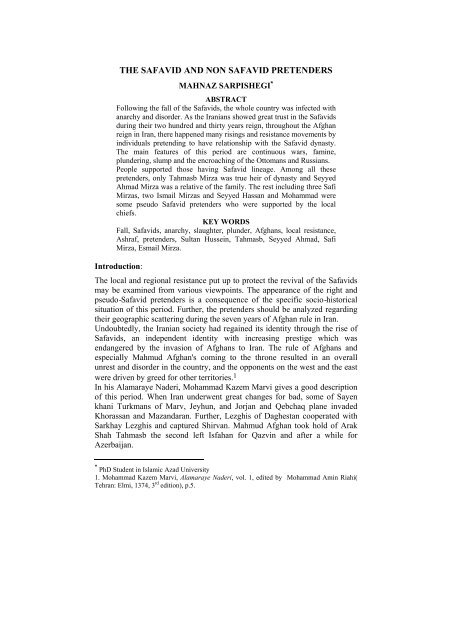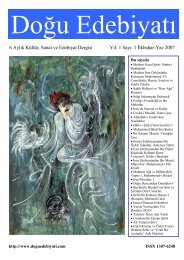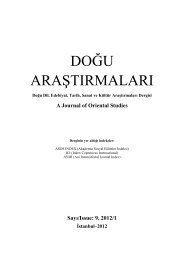A Journal of Oriental Studies Sayı/Issue - Doğu Edebiyatı
A Journal of Oriental Studies Sayı/Issue - Doğu Edebiyatı
A Journal of Oriental Studies Sayı/Issue - Doğu Edebiyatı
Create successful ePaper yourself
Turn your PDF publications into a flip-book with our unique Google optimized e-Paper software.
THE SAFAVID AND NON SAFAVID PRETENDERS<br />
MAHNAZ SARPISHEGI *<br />
ABSTRACT<br />
Following the fall <strong>of</strong> the Safavids, the whole country was infected with<br />
anarchy and disorder. As the Iranians showed great trust in the Safavids<br />
during their two hundred and thirty years reign, throughout the Afghan<br />
reign in Iran, there happened many risings and resistance movements by<br />
individuals pretending to have relationship with the Safavid dynasty.<br />
The main features <strong>of</strong> this period are continuous wars, famine,<br />
plundering, slump and the encroaching <strong>of</strong> the Ottomans and Russians.<br />
People supported those having Safavid lineage. Among all these<br />
pretenders, only Tahmasb Mirza was true heir <strong>of</strong> dynasty and Seyyed<br />
Ahmad Mirza was a relative <strong>of</strong> the family. The rest including three Safi<br />
Mirzas, two Ismail Mirzas and Seyyed Hassan and Mohammad were<br />
some pseudo Safavid pretenders who were supported by the local<br />
chiefs.<br />
KEY WORDS<br />
Fall, Safavids, anarchy, slaughter, plunder, Afghans, local resistance,<br />
Ashraf, pretenders, Sultan Hussein, Tahmasb, Seyyed Ahmad, Safi<br />
Mirza, Esmail Mirza.<br />
Introduction:<br />
The local and regional resistance put up to protect the revival <strong>of</strong> the Safavids<br />
may be examined from various viewpoints. The appearance <strong>of</strong> the right and<br />
pseudo-Safavid pretenders is a consequence <strong>of</strong> the specific socio-historical<br />
situation <strong>of</strong> this period. Further, the pretenders should be analyzed regarding<br />
their geographic scattering during the seven years <strong>of</strong> Afghan rule in Iran.<br />
Undoubtedly, the Iranian society had regained its identity through the rise <strong>of</strong><br />
Safavids, an independent identity with increasing prestige which was<br />
endangered by the invasion <strong>of</strong> Afghans to Iran. The rule <strong>of</strong> Afghans and<br />
especially Mahmud Afghan's coming to the throne resulted in an overall<br />
unrest and disorder in the country, and the opponents on the west and the east<br />
were driven by greed for other territories. 1<br />
In his Alamaraye Naderi, Mohammad Kazem Marvi gives a good description<br />
<strong>of</strong> this period. When Iran underwent great changes for bad, some <strong>of</strong> Sayen<br />
khani Turkmans <strong>of</strong> Marv, Jeyhun, and Jorjan and Qebchaq plane invaded<br />
Khorassan and Mazandaran. Further, Lezghis <strong>of</strong> Daghestan cooperated with<br />
Sarkhay Lezghis and captured Shirvan. Mahmud Afghan took hold <strong>of</strong> Arak<br />
Shah Tahmasb the second left Isfahan for Qazvin and after a while for<br />
Azerbaijan.<br />
* PhD Student in Islamic Azad University<br />
1. Mohammad Kazem Marvi, Alamaraye Naderi, vol. 1, edited by Mohammad Amin Riahi(<br />
Tehran: Elmi, 1374, 3 rd edition), p.5.





